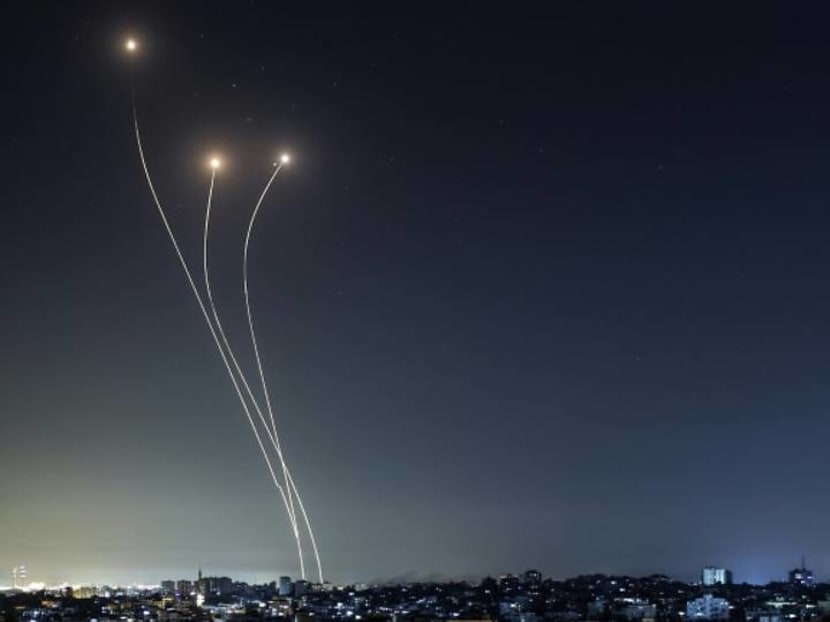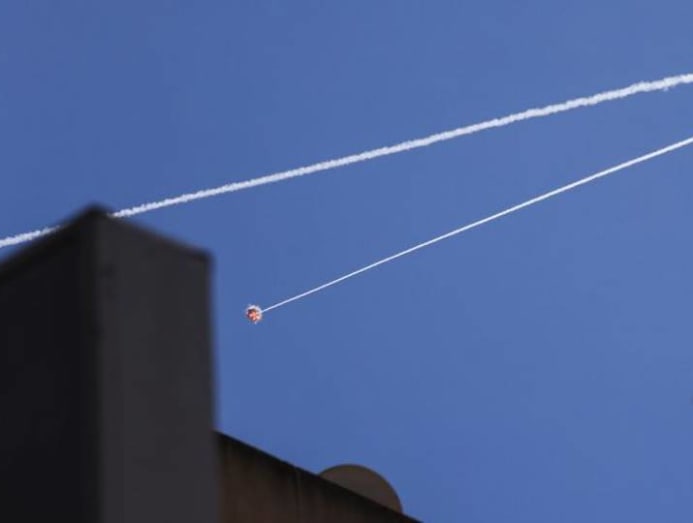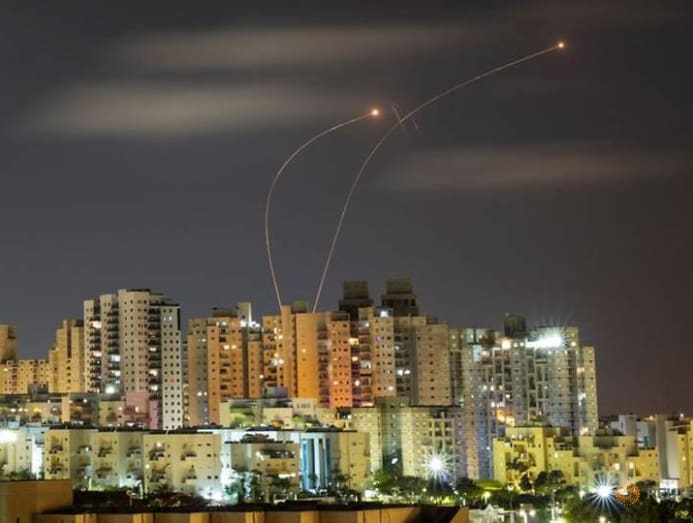commentary Commentary
Commentary: How Israel’s Iron Dome became a double-edged sword
The Iron Dome air defence system against rockets was a game-changer for Israel – including in ways that have also been unfortunate, says defence analyst Mike Yeo.

Israel's army said the Iron Dome anti-missile system had intercepted more than 1,000 rockets fired from Gaza. (Photo: AFP/Mahmud Hams)
SINGAPORE: It’s been more than a week since Israel and Hamas agreed to halt attacks, with both sides beginning to survey the damages wrought in this latest outbreak of hostilities.
Palestinian officials estimate reconstruction to cost tens of millions of dollars, with the death toll at 253 and 1,900 wounded after fresh Israeli air strikes pummelled Gaza.
Israel in contrast saw hundreds treated for injuries with 13 dead.
These numbers underpinning criticism of Israel using disproportionate force highlight the gargantuan task facing the prospects for peace and a lasting solution to the conflict, as US Secretary of State Antony Blinken attempts to build on the ceasefire while in the Middle East this week.
READ: Commentary: Can boycotts over Gaza conflict achieve their intended objectives?
THE IRON DOME’S VAST CAPABILITIES
The videos and spectacular night-time photos of the Israel’s Iron Dome air defence missiles shooting down rockets launched by the militant group Hamas from Gaza towards Israel have been some of the most talked about visuals of the latest round of clashes.
The Iron Dome, designed by Israel’s Rafael Advanced Defense Systems, is a radar-guided, all-weather mobile air defence system for defending against projectiles fired from up to 70km. It has proven capable in intercepting incoming rockets and artillery shells, but it can also target drones and other aircraft .
Each Iron Dome system comprises three to four launcher units organised into a single battery reportedly able to protect an area of roughly 150 sq km, with each launcher unit holding 20 highly manoeuvrable Tamir interceptors that can reach up to an altitude of 10km.
The interceptors are controlled by operators located in a Battle Management & Weapon Control centre. This centre also calculates the impact point of incoming projectiles detected and tracked by the Iron Dome’s radar to determine whether the target constitutes a threat to the area defended.

The system then uses this data to decide if the target projectile needs to be intercepted by one of the expensive Tamir interceptors, fitted with a proximity fuse that detonates its explosive warhead when close to the targeted projectile, with the intention of destroying it or at least knocking it off-course.
The radar associated with the Iron Dome is the EL/M-2084 designed and built by Israeli defence company, the Israel Aerospace Industries electronic systems arm Elta. It is an electronically scanned multi-mode radar capable of detecting aircraft and pinpointing the source of hostile rocket and artillery fire.
The radar can also guide the missiles of other air defence systems such as the radar-guided Derby missiles that make up the SPYDER surface-to-air missile system. Both the radar and SPYDER are operated by Singapore, being components of the Republic of Singapore Air Force’s integrated Island Air Defence System. The missile system is also used in the region by India, the Philippines and Vietnam.
READ: Commentary: Israeli military can't win in Gaza conflict, no matter how powerful it is
THE IRON DOME A GAME-CHANGER FOR ISRAEL
Iron Dome was conceived as far back as the late 1990s, when the Lebanon-based, Iranian backed militant group Hezbollah started shooting rockets at Israeli population centres, culminating in the 34-day war between both sides in 2006.
Triggered by a Hezbollah raid on an Israeli armoured patrol that saw the killing and kidnapping of Israeli Defence Force (IDF) soldiers, Hezbollah subsequently rained down some 4,000 rockets on Israel, resulting in the deaths of 160 Israeli soldiers and civilians.
This was in addition to the threat of similar rockets from Hamas and other Palestinian militant groups, who fired some 8,000 at Israel between 2000 and 2008.
READ: Commentary: In Indonesia, Gaza conflict is fodder for politicians hoping to score points
Such rocket attacks were described as war crimes by Human Rights Watch and Amnesty International, and condemned as acts of terrorism by the United Nations. Until the introduction of Iron Dome, Israel had no means of targeting the rockets once they were launched.
Identifying, watching and attacking rocket well-hidden launch sites often situated near civilians was also a risky, time- and resource-consuming affair.
But the successful introduction of Iron Dome in 2011 changed the game for Israel, in particular for the residents of towns and cities within range of the rockets.

This was demonstrated consistently over the past 10 years during the IDF’s Operations Pillar of Defense, Protective Edge and House of Cards in 2012, 2014 and 2018 respectively. Israeli officiates estimate the Iron Dome managed a success rate of between 85 and 95 per cent in intercepting the rockets it set out to hit.
BLUNTING HAMAS’ ABILITY TO HURT ISRAEL
With the Iron Dome in place, while targeted residents are still activated to head to air raid shelters during attacks, the system’s reported success rate in the region of 90 per cent against the rockets targeted significantly dents the ability of Israel’s enemies in inflicting hurt on the country.
The system has also convincingly answered questions about its ability to deal with saturation attacks during the latest round of battles. Videos from the recent conflict show the system can deal with barrages in excess of 20 rockets fired almost simultaneously.
Iron Dome has also demonstrated its ability to intercept drones during the latest conflict, with at least one bomb-laden drone launched from Gaza destroyed by a Tamir interceptor.
READ: Commentary: China’s cheap drones are finally taking off, with many uses and huge implications
NOT AN INVINCIBLE SYSTEM
Still, the Iron Dome is not an invincible system without shortcomings. There are kinks to be worked out where it accidentally took down an Israeli military Skylark drone conducting a reconnaissance mission, in an incident whose circumstances is being investigated.
A lot has also been made of the high cost of the Iron Dome, with some critics citing the asymmetry of using a costly system (each Tamir interceptor reportedly costing US$100,000 and the R&D effort to develop Iron Dome put at US$210 million) to counter Hamas rockets that cost as little as US$500 to produce.
However, this argument misses the point, because the potential cost of material damage, injuries and death to civilians if the rockets were not intercepted has to be factored in, along with the political costs if the government of the day were seen as not doing enough to protect people and stop the rockets.
READ: Commentary: Gaza conflict puts Israel's Arab partners in awkward position
DOUBLE-EDGED SWORD
However, the success of Iron Dome could also have an unintended effect, as it has further cemented Israel’s already crushing military superiority over the Palestinians.
Israeli journalist Yaakov Katz, who has co-written a book on Israel’s arms industry, pointed out: “Iron Dome allows (Israel) to almost ignore the fact that you have a neighbour just across the border with thousands of rockets pointed at you, because they can no longer really harm you. Iron Dome allows you not to find deeper solutions for that problem."

The problem is of course, Israel’s continued occupation and construction of settlements in the West Bank and a near-total blockade of the Hamas-controlled Gaza Strip, which has led to extremely harsh conditions for Palestinian civilians living in both areas.
With their lives no longer threatened as much as before by the rockets launched from Gaza due to the protection offered by Iron Dome, Israelis may no longer feel an urgent need to solve the Palestinian issue.
This is borne out in polling done by Israeli pollster Dahlia Scheindlin, who found that Israelis rank security first on their list of priorities while resolving the conflict with the Palestinians comes in at fifth or sixth place, in effect seeing the latter issue as divorced from the former.
READ: Commentary: Israel's master plan for Palestine has failed
This has also strengthened the positions of Israeli hardliners, including Prime Minister Benjamin Netanyahu, who have arguably less incentive to seek a workable diplomatic solution to the seemingly intractable core issue of the status of the West Bank and Gaza.
To borrow an analogy from the world of quality assurance, Iron Dome is a corrective action, and an effective one at that, for addressing the problem of incoming rockets.
But it cannot address the root cause of why the rockets continue to come – something that the world will be watching and wondering long after Mr Blinken returns to the US.
Mike Yeo is the Asia reporter for US-based defence publication Defense News.





